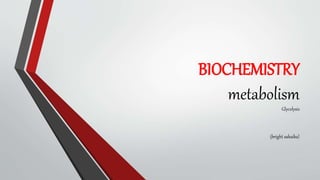
BIOCHEMISTRY bright sakaika.pptx
- 2. objectives By the end of this presentation you should be able to : 1. Define metabolism and its types 2. Define glycolysis 3. Describe and illustrate glycolysis pathway 4. Amount of ATP produced in glycolysis 5. Importance of glycolysis
- 3. Introduction • Metabolism is a process where living organisms acquire and utilize (make use of) energy for various body functions. • Types • Anabolism : involves the synthesis of complex molecules from simpler molecules (energy is used) e.g synthesis of glycogen from glucose • Catabolism : is the breakdown of complex molecules to their constituents (energy is produced) e.g food digestion
- 4. Glycolysis • Glycolysis is a series of metabolic processes that metabolize glucose molecule into two pyruvate molecules. • Occurs in cytosol of the cell. • it takes 10 steps of enzymatic reactions to degrade one molecule of glucose into two pyruvates. • Glucose is a 6-carbon molecule while pyruvate is made up of 3 carbon atoms
- 5. Glycolysis cont… • High energy molecules are produced in glycolysis these are i. ATP (adenosine triphosphate) ii. NADH ( reduced nicotinamide adenine dinucleotide)
- 6. Stepsofglycolysis The following is a series of reactions that take place in glycolysis
- 7. Step 1: phosphorylation of glucose • An enzyme hexokinase catalyzes the phosphorylation of glucose to form glucose-6-phoshate • ATP is utilized forming ADP
- 8. Step 2: isomerization of G6P • Glucose-6-phosphate is isomerized to fructose-6- phosphate by an enzyme phosphoglucose isomerase
- 9. Step 3: phosphorylation of FBP • Fructose-6phosphate gets phosphorylated to form fructose-1,6-phosphate. • This reaction is catalyzed by an enzyme phosphofructokinase • ATP is utilized and ADP is produced
- 10. Step 4: cleavage of FBP • A six carbon compound FBP splits into two 3-carbon compounds GAP and DHAP by the help of an enzyme adolase
- 11. Step 5: isomerization • Triose phosphate isomerase catalyzes the isomerization of DHAP to GAP. • Only GAP can proceed in the glycolysis so a ketose DHAP is converted to an aldose GAP.
- 12. Note: We started with one glucose molecule (6-carbon molecule) In reaction 5 two trioses (3-carbon molecules) are produced and each GAP molecule proceeds in a different path Two ATPs have been used
- 13. Lets now look at reactions that will produce energy
- 14. Step 6: oxidation of GAP • GAP gets oxidized by NAD+ and Pi forming 1,3-bisphophoglycerate • This reaction is catalyzed by glyceraldehyde-3-phosphate dehydrogenase • NADH is produced by reducing NAD+
- 15. Step 7: First ATP synthesis • 1,3-BPG gets dephosphorylated to form 3-phosphoglycerate • ATP is produced
- 16. Rxn 8: phosphoglycerate Mutase • Phosphoryl group of 3GP is tranferred to a second carbon forming 2- phosphoglycerate. • This reaction is catalyzed by phosphoglycerate mutase
- 17. Rxn 9: dehydration of 2GP • Enolase catalyzes the dehydration of 2- phosphoglycerate to phosphoenolpyruvate
- 18. Rxn 10: second ATP synthesis • Pyruvate kinase catalyzes the formation of pyruvate from phosphoenolpyruvate. • ATP is produced.
- 19. ATP • From reaction 6, energy starts to be produced 1 NADH 2 ATP • Remember from stage 5, 2GAP were produced and each one goes into a different reaction • Therefore at the end of each reaction we produced one pyruvate molecule and one NADH and two ATPs • Combining both reactions we have 2 pyruvates, 2 NADH and 4 ATPs
- 20. ATP cont.. • Recall we used 2 ATP molecules and produced 4 • So the overall ATP = 2 • 1 NADH = 2.5 ATP • Therefore at the end we have 2 ATP + (2 × 2.5) ATP = 2 + 5 = 7 ATP
- 21. Importance of glycolysis • Production of energy • It is quick disadvantage oHowever the energy produced is minimal
- 22. •Thank you •Don’t forget to subscribe